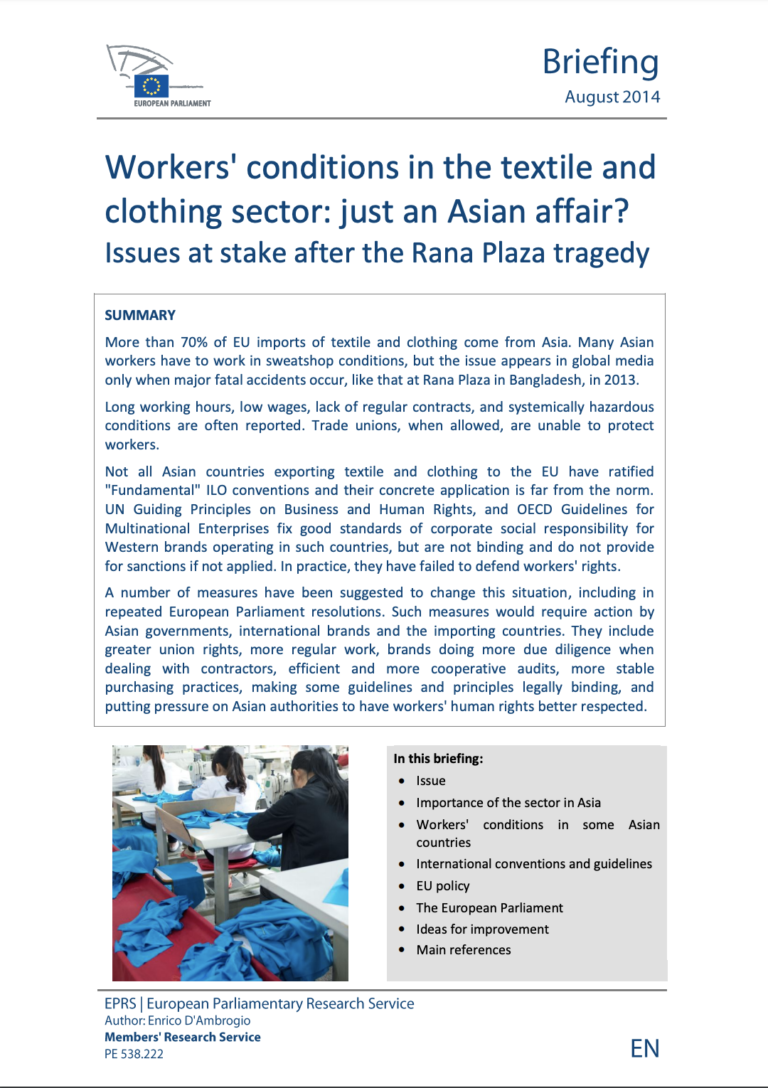Guiding Principles on Business and Human Rights
The UN Guiding Principles on Business and Human Rights are a set of guidelines for States and companies to prevent, address and remedy human rights abuses committed in business operations. child labour
Written by Enrico D’Ambrogio
More than 70% of EU imports of textile and clothing come from Asia. Many Asian workers have to work in sweatshop conditions, but the issue appears in global media only when major fatal accidents occur, like that at Rana Plaza in Bangladesh, in 2013.
Long working hours, low wages, lack of regular contracts, and systemically hazardous conditions are often reported. Trade unions, when allowed, are unable to protect workers.
Not all Asian countries exporting textile and clothing to the EU have ratified “Fundamental” ILO conventions and their concrete application is far from the norm. UN Guiding Principles on Business and Human Rights, and OECD Guidelines for Multinational Enterprises fix good standards of corporate social responsibility for Western brands operating in such countries, but are not binding and do not provide for sanctions if not applied. In practice, they have failed to defend workers’ rights.
A number of measures have been suggested to change this situation, including in repeated European Parliament resolutions. Such measures would require action by Asian governments, international brands and the importing countries. They include greater union rights, more regular work, brands doing more due diligence when dealing with contractors, efficient and more cooperative audits, more stable purchasing practices, making some guidelines and principles legally binding, and putting pressure on Asian authorities to have workers’ human rights better respected.

The UN Guiding Principles on Business and Human Rights are a set of guidelines for States and companies to prevent, address and remedy human rights abuses committed in business operations. child labour
The OECD Guidelines for Multinational Enterprises are recommendations addressed by governments to multinational enterprises operating in or from adhering countries. They provide non-binding principles and standards for responsible business conduct in a global context consistent with applicable laws and internationally...
Annual report of the Attorney General on efforts to combat human trafficking in the US. Provides and assessment of all U.S. Government activities regarding human trafficking in 2012. Details activities related to immigration benefits for victims, ...Read More
The decision calls on OSCE participating States to: • Consider ensuring that contractors who knowingly use subcontractors involved in traf- ficking for labour exploitation can be held accountable for that crime; • Develop programmes to curb th...Read More
Statement by the Global Alliance Against Traffic in Women on the occasion of International Women’s Day and ahead of the 63rd session of the UN Commission on the Status of Women. The Global Alliance Against Traffic in Women calls on states to i...Read More
Labour migration may benefit employers and workers, and across the world recruitment agencies play an important role in matching migrant workers with available jobs. However, while the cost of recruitment of higher skilled migrant workers tends to b...Read More